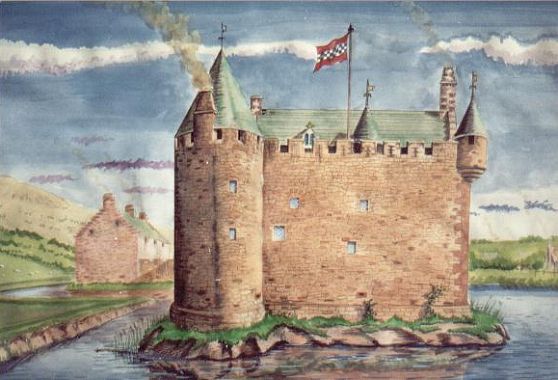 To the
north of the ancient market town of Haddington behind the Garleton hills
sits the ruin of Garleton castle, with an intact crow stepped gabled
hall-house, a row of modern cottages which incorporate earlier castle
material (including 16th century cannon-loops) and the remains of a drum
tower with three basement vaults set into an angled wall. L-plan
in form, these vaults which suggest the distribution of weight from
several levels above are
all that remain of the castle raised in the late 1500's by Sir John
Seton (treasurer of the household and Lord of Session under King James
VI of Scots 1567-1625) on land originally owned by the Lyndsay family of
nearby Byres castle. Locally the Lyndsays also held Luffness castle
beside Aberlady and lands around
Ormiston
which the later signed over to the Cockburn family.
To the
north of the ancient market town of Haddington behind the Garleton hills
sits the ruin of Garleton castle, with an intact crow stepped gabled
hall-house, a row of modern cottages which incorporate earlier castle
material (including 16th century cannon-loops) and the remains of a drum
tower with three basement vaults set into an angled wall. L-plan
in form, these vaults which suggest the distribution of weight from
several levels above are
all that remain of the castle raised in the late 1500's by Sir John
Seton (treasurer of the household and Lord of Session under King James
VI of Scots 1567-1625) on land originally owned by the Lyndsay family of
nearby Byres castle. Locally the Lyndsays also held Luffness castle
beside Aberlady and lands around
Ormiston
which the later signed over to the Cockburn family.
Garleton incorporates fabric from an earlier Lyndsay tower on
the site, and rubble taken from Byres castle as it
appears to have been dismantled by the English in 1548 to ensure the
security of their 'Fortress of Haddingtoun' during the wars of the
'Rough Wooing' (1544-1550) where by the use of castle sacking they hoped to
force the marriage of the infant Mary Queen of Scots to the
English Prince Edward. The Seton family suffered heavily during these
times with the burning of Seton Palace, Seton Collegiate church and the
destruction of
Winton
Castle in 1544. In 1724
Garleton was sold to the Earl of Wemyss. The presence of the modern
cottages on site highlights the common practice of Victorian builders to
dismantle such ancient towers as Garleton viewing them as ready made
quarries failing to appreciate their historical and architectural value.